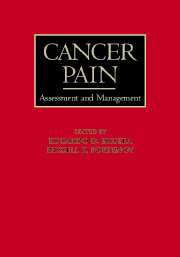Book contents
- Frontmatter
- Contents
- List of contributors
- Preface
- SECTION I MECHANISMS AND EPIDEMIOLOGY
- SECTION II ASSESSMENT AND SYNDROMES
- SECTION III PHARMACOLOGICAL TREATMENT
- 7 Pharmacology of analgesia: basic principles
- 8 Pharmacology of opioid analgesia: clinical principles
- 9 Opioid side effects and management
- 10 Nonopioid analgesics
- 11 Adjuvant analgesic drugs
- SECTION IV NONPHARMACOLOGICAL APPROACHES
- SECTION V THE ROLE OF ANTINEOPLASTIC THERAPIES IN PAIN CONTROL
- SECTION VI PAIN IN SPECIAL POPULATIONS
- SECTION VII DIFFICULT PAIN PROBLEMS
- SECTION VIII SPECIAL TOPICS
- Index
8 - Pharmacology of opioid analgesia: clinical principles
from SECTION III - PHARMACOLOGICAL TREATMENT
Published online by Cambridge University Press: 08 October 2009
- Frontmatter
- Contents
- List of contributors
- Preface
- SECTION I MECHANISMS AND EPIDEMIOLOGY
- SECTION II ASSESSMENT AND SYNDROMES
- SECTION III PHARMACOLOGICAL TREATMENT
- 7 Pharmacology of analgesia: basic principles
- 8 Pharmacology of opioid analgesia: clinical principles
- 9 Opioid side effects and management
- 10 Nonopioid analgesics
- 11 Adjuvant analgesic drugs
- SECTION IV NONPHARMACOLOGICAL APPROACHES
- SECTION V THE ROLE OF ANTINEOPLASTIC THERAPIES IN PAIN CONTROL
- SECTION VI PAIN IN SPECIAL POPULATIONS
- SECTION VII DIFFICULT PAIN PROBLEMS
- SECTION VIII SPECIAL TOPICS
- Index
Summary
Introduction
According to the World Health Organization (WHO) guidelines, opioid analgesics are the mainstay of analgesic therapy and are classified according to their ability to control mild to moderate pain (codeine, tramadol, dextropropoxyphene) (second step of the WHO analgesic ladder) and to control moderate to severe pain (morphine, methadone, oxycodone, buprenorphine, hydromorphone, fentanyl, heroin) (third step of the WHO analgesic ladder) (1,2). Opioid analgesics can be associated with non-opioid drugs such as paracetamol or with nonsteroidal anti-inflammatory drugs (NSAIDs) and to adjuvant drugs (3).
The current recommended management of cancer pain consists of the regular administration of opioids and intermittent rescue doses of opioids or NSAIDs for excess pain. Individualized pain management should take into account the intensity of pain and its nature, concurrent medical conditions, and above all the subjective perception of the intensity of pain that is not proportional to the type or to the extension of the tissue damage but depends on the interaction of physical, cultural, and emotional factors.
Oral route of opioid administration remains the preferred one. However, in some clinical situations such as vomiting, dysphagia, confusion, and where rapid dose escalation is necessary, oral administration may be impossible, and alternative routes must be implemented (4,5). Table 8.1 shows the potential application of the different routes of opioid administration (6).
Intraindividual variability in response to different opioids is a common clinical phenomenon. Different explanations have been proposed such as the genetic makeup, tolerance to different opioid effects, the incomplete cross-tolerance among opioids selective for the same receptor subtype due to differential affinity for receptor subtypes, the differences in profile of active metabolites between various opioids (7–12), and the pain mechanism (13).
- Type
- Chapter
- Information
- Cancer PainAssessment and Management, pp. 124 - 149Publisher: Cambridge University PressPrint publication year: 2003
- 1
- Cited by



